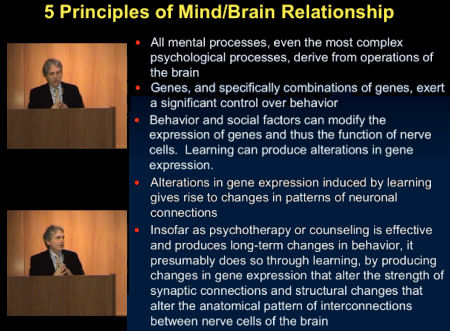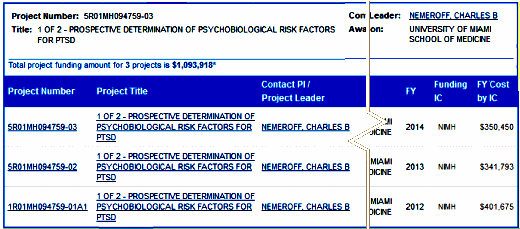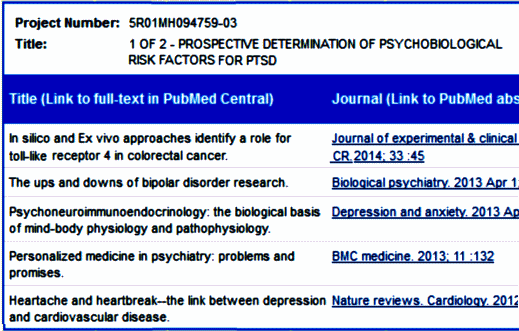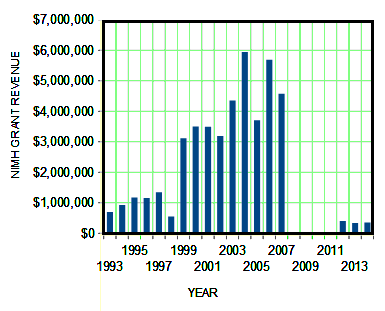It’s unlikely that anyone reading this blog or following the peculiar trajectory of academic and organized psychiatry doesn’t know a lot about Charlie Nemeroff and his fall from "Boss 0f Bosses" as Chairman at Emory. He’s become a paradigm for so many things – ghost writing, conflicts of interest, speaker’s bureaus, advisory boards, wheelings-and-dealings, etc. After the fall in 2008, he landed on his feet as Chairman in Miami by 2009 and by 2012 he got himself back on the Grand Rounds Circuit with the topic, The Neurobiology of Child Abuse: Treatment Implications and as an NIMH grantee with PROSPECTIVE DETERMINATION OF PSYCHOBIOLOGICAL RISK FACTORS FOR PTSD [speechless…].
During Dr. Nemeroff’s time as Chairman at Emory, I had already left the Department there as a full time faculty person during the revolution in psychiatry in the 1980s, remaining on the clinical faculty. One interest was PTSD, the psychological part, but I didn’t even know that the chairman of my department was following this other path, one he still follows. I don’t personally believe PTSD has anything to do do with neurobiology or psychobiology, but what I think is not what this post is about. It’s about something known as grantsmanship and wasted research dollars.
I’m not the only person that follows the Travels with Charlie. Carl Elliot of Fear and Loathing in Bioethics points us to Dr. Nemeroff’s coming visit to the Department of Psychiatry at his University of Minnesota.
| Grand Rounds – 2014-2015 | |
|
|
|
| September 3, 2014 | Grand Rounds: TBD Presenter: Charles B. Nemeroff, MD, Professor and Chair, Dept. of Psychiatry and Behavioral Sciences and Director, Center on Aging, University of Miami |
I don’t know if the topic will be The Neurobiology of Child Abuse: Treatment Implications like it was at NYU or in London. The video of the NYU version has unfortunately been taken down, but here’s a synopsis of his closing slides:

I don’t happen to believe any of the speculative parts of that [3, 4, & 5]are known or even likely, but like I said, what I think is not what this post is about. Here’s a piece of that grant write-up for orientation:
| Although the majority of trauma victims experience the cardinal symptoms of re-experiencing, avoidance and hyperarousal, for the large majority of such individuals, these symptoms do not become chronic nor do they develop syndromal PTSD. It is important to identify the large minority of trauma victims with a high likelihood of developing PTSD because of the very significant medical and psychiatric morbidity and mortality associated with this disorder. There is already considerable evidence that the likelihood of developing PTSD after trauma exposure is due to a combination of genetic and environmental factors. This two-site, linked R-01 application seeks to utilize state-of-the art advances in genomics, transcriptomics and epigenetics, coupled with comprehensive clinical and psychological measures, to address this seminal unanswered question in PTSD clinical service and research… |
I don’t happen to believe there is"already considerable evidence that the likelihood of developing PTSD after trauma exposure is due to a combination of genetic and environmental factors" either, but…
So to the grant itself. So far, we’re into it for a bit over a million NIMH dollars. This is the second time around for this project. Last time, they recruited subjects from hospital waiting rooms and ads on rapid transit [MARTA]. How did they get funded to do it again? I’m not sure, but I think it’s that they’re taking different measurements and using different analyses [?], but what I really think is that Dr. Nemeroff is a master of grantsmanship…
| To achieve this goal, 500 trauma-exposed subjects will be recruited at the University of Miami Ryder Trauma Center and the Emory University affiliated Grady Memorial Hospital and followed at regular intervals for one year. This focused, hypothesis-driven study will scrutinize previously identified psychological and biological risk factors. Genetic risk factors include polymorphisms of the ADCYAP1R1, FKBP5, DAT, BDNF, COMT, CRFR1, 5HTTLPR, RGS2, GABA2 and 5HT3R genes, novel genetic and epigenetic risk factors and most importantly, the primary downstream effects of these genomic and epigenetic findings by the use of conventional and newer statistical modeling methods. |

We were all mystified that he got an NIMH grant at all with his track record [speechless…], and particularly with this topic – a tired remnant from the days when the biology-is-everything mantra was king. I doubt that anyone much thinks that anything will come from this study. So why would he be so quickly rehired after being definitively discredited and how did he get a grant for this of all topics? That is what this post is about. Back in the day, Dr. Nemeroff became the paradigmatic insider. He knew all the people in power [some of whom he’d helped to get there]. And he was an expert in parlaying his influence in raising money from the pharmaceutical companies and the NIMH. He got away with some outrageous antics because he brought home the money to his university and department, so people looked the other way. Even in disgrace, he was still an effective power broke – thus landing on his feet. And what’s the point? He’s still bringing home the bread. And, oh look, three fifths of the way through this grant life, what has been charged to it?

It’s pretty easy to see that these articles don’t have anything to do with the PROSPECTIVE DETERMINATION OF PSYCHOBIOLOGICAL RISK FACTORS FOR PTSD. But that’s not to say that the study isn’t going on. I expect at the end we’ll be treated to slides of findings added to those from the other time around. But it’s highly unlikely that the results will add anything to our understanding of biology or PTSD. At best, they will become references for a further grant application. Over the course of the years, Dr. Nemeroff has been PI on ~$45M worth of NIMH Grants. To my knowledge, none have produced anything that is a lasting addition to the scientific record [note the Senator Grassley Gap 2008-2011]:

When I hear the criticisms of the modern bio-bio-bio psychiatry, while I often agree, I add something else in my mind – motives. The upper layer of academic psychiatry is populated predominantly by people selected by their medical schools because they can do some version of what’s described in this post – bring home the bacon from the NIMH, industry, foundations, et cetera. And for thirty plus years, they’ve talked about little other than biological research and pharmaceutical studies, selecting their future academic colleagues from the like-minded pool [that got us where we are today]. Dr. Nemeroff isn’t an exception, he’s just bolder, more reckless – reckless enough to have been busted for a time. And that’s just the NIMH story. The financing from pharmaceutical companies was probably even more impressive, and flexed the same muscles as the NIMH grantsmanship. He’s just one among many. I recently described a $50M version from UT Southwestern [retire the side…] – equally expensive, with equally non-memorable results. And there are too many more examples.
by Boadie W Dunlop,corresponding author1 Barbara O Rothbaum,1 Elisabeth B Binder,1,2 Erica Duncan, Philip D Harvey, Tanja Jovanovic,1 Mary E Kelley,5 Becky Kinkead, Michael Kutner,5 Dan V Iosifescu, Sanjay J Mathew,7 Thomas C Neylan,8 Clinton D Kilts, Charles B Nemeroff, and Helen S MaybergTrials. 2014; 15: 240.
Acknowledgements
Funding for the study is provided from a grant from the National Institute of Mental Health, U19 MH069056 (BWD, HM). Additional support was received from K23 MH086690 (BWD) and VA CSRD Project ID 09S-NIMH-002 (TCN). GlaxoSmithKline contributed the study medication and matching placebo, as well as funds to support subject recruitment and laboratory testing. GSK is uninvolved in the data collection, data analysis (excepting some pharmacokinetic analysis), or interpretation of findings. The GSK561679 compound is currently licensed by Neurocrine Biosciences, which will also perform pharmacokinetic analyses.
by Nemeroff CB, Widerlöv E, Bissette G, Walléus H, Karlsson I, Eklund K, Kilts CD, Loosen PT, Vale W.Science. 1984 Dec 14;226(4680):1342-4.
The possibility that hypersecretion of corticotropin-releasing factor (CRF) contributes to the hyperactivity of the hypothalamo-pituitary-adrenal axis observed in patients with major depression was investigated by measuring the concentration of this peptide in cerebrospinal fluid of normal healthy volunteers and in drug-free patients with DSM-III diagnoses of major depression, schizophrenia, or dementia. When compared to the controls and the other diagnostic groups, the patients with major depression showed significantly increased cerebrospinal fluid concentrations of CRF-like immunoreactivity; in 11 of the 23 depressed patients this immunoreactivity was greater than the highest value in the normal controls. These findings are concordant with the hypothesis that CRF hypersecretion is, at least in part, responsible for the hyperactivity of the hypothalamo-pituitary-adrenal axis characteristic of major depression.hat-tip to James O’Brien…
All mental processes, even the most complex psychological processes, derive from operations of the brain.
Wow. This comes as quite a shock.
I’m trying to learn the ins and outs of statistical measures and foundational questions about RCTs. Isn’t what he says about the relationship between genetics, epigenetics and mental illness also based on hypotheses, so that his study is designed to test the hypothesis of hypothesis and so may be more of a Type 1 error than contain one? His grant could be little more than getting paid to cherry pick and make post hoc generalizations based on concepts that aren’t as well supported as he pretends them to be?
I’d be impressed if he tried to prove his hypothesis false first.
One could say a great deal about this issue. In Nemeroff’s case, the term that comes to my mind is impresario not scientist. And Wiley nailed it with her comment: he is not known for conducting what John Platt called strong inference studies. Why does NIMH waste our money on his weak projects? I have talked about that before. We see here an example of regulatory capture. And President Eisenhower’s warnings about the academic-government-industrial complex are coming true.
I feel the issue is wider. Noted is the rise of the insider, I feel what we have is an academic elite who in reality talk a great deal about their greatness and the inability of those around to see the point of the pointless research they are doing, funded of course with public dollars.
Medicine has close ties to the academic institutions of our country, as do other endeavors, resulting in this “pay no attention to that man behind the curtain” mentality. University presidents fly in private jets, clergy are no longer responsible to their congregations since they are above reproach, and ask any 20 year old if they are entitled.
This is the norm; every person has become their own expert. A 35 year old plumber was replacing my water heater a few weeks ago and had no good words to say about the 20 year olds he knew who felt above him and everyone else.
Dr. Nemeroff is only one of many who have pushed this concept out of academia and into the broader world. In my state the immediate past president of Big U has been found to have left behind many scandals. There is never a worry since there is never a penalty, he moved on to another job as President of another university.
Steve Lucas
the Emory-GlaxoSmithKline-NIMH Collaborative Mood Disorders Initiative 5U19MH069056
There’s a thought stopper.
It goes beyond naked greed. He’s academically toxic and no one should trust him, much less give him millions.
It seems to me that interdisciplinary study (translational) in medicine should be about working toward understanding what medicine is doing more completely—exploring what is happening inside the human body in more depth and gaining a deeper understanding of disease mechanisms and causes; and what effects drugs and other interventions have on what conditions and what effects they have otherwise in what people.
Large RCTs are too easily irrelevant to individuals. Multiple small but very specific studies could demonstrate more, cost much less, and be more relevant to clinicians and patients. Psychiatry, especially should be working on more narrow targets, but since the KOLs are busy trying to prove that everyone on the planet has a mental illness, the focus on those who are in critical need of long term help and some drug treatment is lost in the drive to boost profits for KOLs and drug companies to infinity, because that’s what publicly owned corporations are required to do.
Academia is dirty these days and for profit healthcare is one ugly, but financially dear beast.
The brainstem reflex of private practitioners fawning over KOLs needs to stop.
Academia is corrupted beyond recognition.
So, the purpose of this study is to find a link between “epigenetic risk factors” for predetermining who is susceptible to PTSD? To what end?
I’d bet you could put what Nemeroff knows or thinks he knows about epigenetics and heritability in a comic book about twin studies. And I’d bet the whole edifice of epigenetics and disease is based on a misunderstanding— perhaps willfully in some cases— of genetics. Once again, he’s jumping on the gravy train of what might be totally misguided efforts to solve problems through crank hypotheses.
I’ve gotten excited about possibilities I’ve seen in the study of epigenetics, but the bottom line was that environment influences can protect us from chronic mental problems. So, it’s not necessary to consider these problems from a genetic point of view.
I found the following paper very interesting and wonder when some scientists are going to slam the breaks on millions being spent on bogus research that defies established scientific knowledge. It’s a wonderful read. Here is a long excerpt I wish I could blockquote:
“the problem with heritability, whether of diabetes or any other trait, is that it is not an estimate of what everyone would like it to be, an analysis of biological functional relationships, a measure of how much of a person’s diabetes is caused by her genes. Rather, it is a local, spatiotemporal analysis of variances, an estimation of how much of the genetic variation in a specific population of a specific genetic composition and distribution exposed to a specific range and sequence of environments explains, statistically, that population’s phenotypic variability.
For this reason, heritability coefficients have a place in agriculture and farm-ing, where environments can be manipulated to breed the desired specimens,
yet have no place among human populations. As behavior geneticist Douglas
Wahlsten wrote, “The only practical application of a heritability coefficient is to predict the results of a program of selective breeding”. Thus, heritability measures cannot be useful to health researchers, who do not seek to weed out “bad” genotypes and select “good” ones to produce “desired” traits in the given or current environments, but rather need knowledge that can help improve the health of the patient population they have, inform interventions effective for the greatest number of human genotypes, shed light on which environments will allow population health to flourish, and advocate for them if at all possible—all illuminated by the wealth of knowledge already available about common disorders.
Most importantly, it also follows that if the goal is to improve the public’s health, there are years, if not centuries, of evidence demonstrating which environments are most advantageous to the development of the healthiest human phenotype, regardless of genetic makeup: these are environments in which individuals are assured basic resources for health and well-being from conception on. Further, real medical breakthroughs, like the discovery of insulin or the polio vaccine, did not require an iota of “genetic knowledge” about affected individuals, yet they have saved millions from disability or death for nearly a century, provided the resource was made available. Resource availability, of course, is not a problem of genetics, but of economic and public health policy.
Unfortunately, faced with the mindboggling statistical computations and jargon of genetic studies, uninitiated readers often walk away from these discussions shrugging their shoulders and concluding, quite reasonably, that if their child’s
nose resembles theirs, genes must also influence (i.e., cause) matters of life, health, and death. What’s more (and more troubling), as the mass media reproduce uncritically the views of prominent scientists about the latest genetic
“discovery”—ranging from genes “for” committing crimes, voting conservative , or believing in God —readers often conclude that the contributions of “life, health, and death” genes can be identified, quantified, and targeted with “personalized” strategies and that whoever denies all this must be crazy, ignorant, or an “environmental determinist”.
Of course, as far as I know, this could be bunk, but it’s food for thought, and the last paragraph seems mostly true and obvious to me— not that environmental changes could eliminate mental problems— but that it’s logical to consider what changes can be made and might have impact in the environment first, because tweaking or drugging phenotypes and genotypes first is crazy.
https://www.google.com/?gws_rd=ssl#q=epigenetics+vs+AND+missing+heritability&start=10
https://www.google.com/?gws_rd=ssl#q=epigenetics+vs+AND+missing+heritability&start=10
“the problem with heritability, whether of diabetes or any other trait, is that it is not an estimate of what everyone would like it to be, an analysis of biological functional relationships, a measure of how much of a person’s diabetes is caused by her genes. Rather, it is a local, spatiotemporal analysis of variances, an estimation of how much of the genetic variation in a specific population of a specific genetic composition and distribution exposed to a specific range and sequence of environments explains, statistically, that population’s phenotypic variability.”
It is genuinely absurd that someone engaged in “Scientific” research would not know that. That point was very explicitly made in my college Evolutionary biology class– the one that was geared to non-Science concentraters.
It’s far easier to make the obvious sound cutting edge than to actually come up with an idea that is cutting edge.
James,
Thi$ i$ where hi$ “edge” alway$ “cut$“:
He’s been marching up and down this blind alley for decades:
http://www.ncbi.nlm.nih.gov/pubmed/6334362
Well, EastCoaster, many researchers looking for genetic causes of disease seemed to have missed that boat and have been leaning on weak twin studies for decades. The mad and well-funded search for gene variants to correlate with disease is rife with unscientific fervor. There is, with few exceptions, no there there but money grows on the “logic” trees, so chalk one up to Nemeroff— he’s a hustler.
grantsman, impresario, hustler
All apt terms. Unfortunately, he was also the “leader of the pack” whose antics may have filled many coffers, but did nothing for psychiatric patients or psychiatry’s future. There’s a saying about apples and barrels that seems to apply here…
wiley– I’m not quite grasping your tone in writing, so I just want to say that I wasn’t in any way criticizing your comment when I used the word absurd. What I probably should have said is “appalling.”
My tone is matter of fact, EastCoaster, but I am happy as a clam to be learning about genetics and GWAs lately, and the criticism of the methodologies being used on top of the fact that there is plenty of evidence that it’s a fruitless path, and there is a long history and mountains of evidence for environmental causes of diseases that is not getting funded— that’s where an ounce of prevention is worth a pound of cure. And, prevention is being made into a dirty word for a dirty business.
Come to think of it, what published academic paper has really transformed psychiatry in the past twenty years? This is a thinking out loud question and I’m open to being less cynical.
For the most part, grant money is this:
http://www.theonion.com/video/in-the-know-should-the-government-stop-dumping-mon,14289/